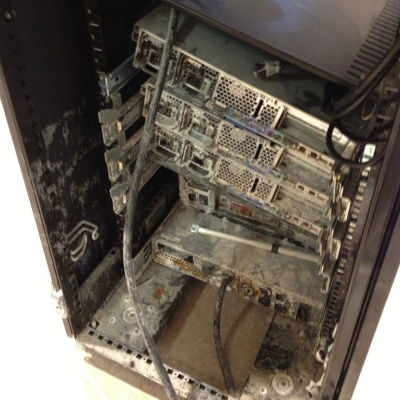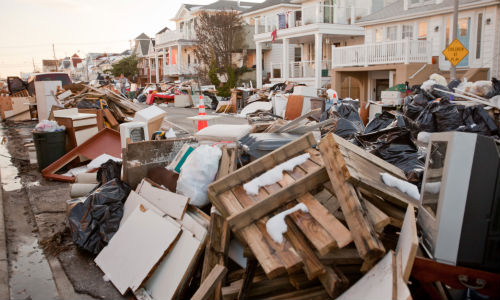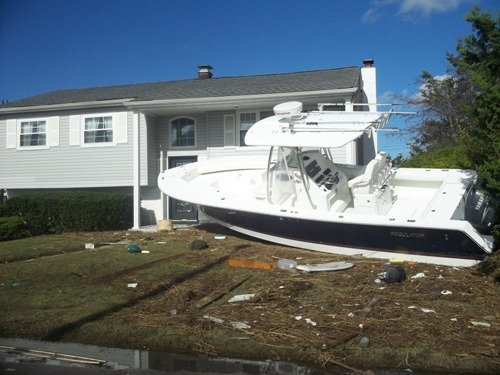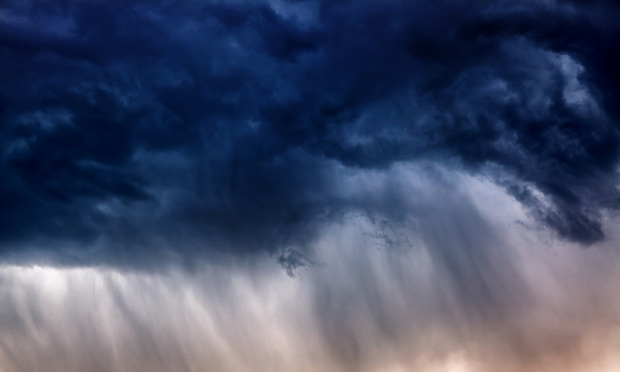Flooding. Power outages. Debris removal. Rebuilding. Many insurance agents faced the same issues as their clients in the wake of Superstorm Sandy, but they all shared an additional responsibility: to make themselves available to the victims of the storm, helping them to process the claims that would help them make their lives whole again.
The following four agents shared their recollections of the superstorm and its aftermath, providing case studies in resiliency and serving as reminders of why many people got into the P&C insurance business to begin with—to help them recover when tragedy strikes.
Clayton N. Sterling Associates: An Island in the Middle of Devastation.
 The office of Clayton N. Sterling Assoc. in Seaside Park, N.J., sits one block from the shore. Preparations to protect the building began on Saturday; on Sunday, the state declared a mandatory evacuation of the barrier islands. Jim Klagholz (pictured left), the agency's president, closed the building and left—but made a fortuitous last-minute decision to return and take his company's workstation tower and computer.
The office of Clayton N. Sterling Assoc. in Seaside Park, N.J., sits one block from the shore. Preparations to protect the building began on Saturday; on Sunday, the state declared a mandatory evacuation of the barrier islands. Jim Klagholz (pictured left), the agency's president, closed the building and left—but made a fortuitous last-minute decision to return and take his company's workstation tower and computer.
The next day, the barrier island “took pretty much a direct hit,” says Klagholz. It would be days before officials would allow residents and business owners in for limited visits. They boarded buses at a nearby mall and handed their driver's licenses over so police could keep tabs on who was coming and going. The mandatory evacuation order lasted until Jan. 1.
Klagholz's office was an island in the middle of devastation on a piece of high-ground leaving his and a few surrounding buildings seemingly unscathed. The flooding shut-off utilities and it would remain that way for over two months.

Above: An aerial photo of damage in Seaside Park, N.J. The orange circle at the top-right corner shows the office of Clayton N. Sterling Assoc., which remained remarkably unscathed (original photo credit: Andrew Mills/The Star Ledger).
Home was a different story; five miles inland in neighboring Toms River, a few trees fell around the house, but there was no damage. He was without electricity for 36 hours. Once it was back on, he got back to work.
With the help of a close friend—who he referred to as a super geek—he reconnected his computer network, transforming his home into a makeshift office. He and his small office staff processed around 700 claims. When customers called the agency the voice mail message informed them that the office was temporarily re-located and to leave a message. Up at 6 a.m., Klagholz received 60 to 70 messages a day. He and his staff spent the day on their cell phones returning calls because Verizon could not hook-up the phone lines he needed.
“I had 250 minutes on my cell phone,” said Klagholz. “I changed that to unlimited and haven't switched back.”
|“I'm kind of a conservative guy, but with the changes in the seasons, I can't help but to question whether we could be going through this again next year” –Jim Klagholz
The performance of insurers has been “all over the board” he says, with some “performing in stellar fashion.” He believes the sheer volume of claims has overwhelmed their capacity, especially the excess and surplus lines carriers and their independent adjusters. He has no illusions about moving on from Sandy any time soon.
“An adjuster asked me, are you ready to put this storm behind you? I said yes. And he said don't, because you will be dealing with this for a year; this was worse than Katrina,” Klagholz remembers. “Most of our work today is claims.”
He learned his first lesson about backing-up computer files when lightning struck the office about two-and-a-half years ago. He eventually began using the cloud storage for backing up his files.
Sandy taught him another lesson: that he not only needed back-up data, but to have back-up hardware and facilities offsite.
“I'm kind of a conservative guy, but with the changes in the seasons, I can't help but to question whether we could be going through this again next year,” he said.
The major lesson coming out of Sandy is that contingency planning can help mitigate damage and ease the recovery process, says Klagholz.
“This takes an emotional toll on people,” he notes. “If they are prepared in advance, they will have a better time of dealing with it if and when it happens again.”
Garber, Atlas Fries & Associates Inc.: Lessons in Contingency Planning
On the Monday that Sandy approached the coast, Chief Operating Officer/Vice President Justin Fries of Garber, Atlas Fries & Assoc., in Oceanside, N.Y., sent a text message to the firm's more than 40 employees telling them to stay home and be safe. He and two others prepared the agency's two-story office by covering equipment and furniture in case the wind broke through a window or lifted a roof seam allowing the rain in.
As he was unable to relocate the firm's server, he covered it up and surrounded with material in hopes of blocking off any floodwater. Tropical Storm Irene had flooded the office slightly the year before; Fries assessed that Sandy could be a little worse, but felt his office was prepared.
At 8:30 that evening, he got a call from the alarm company: Sensors detected water coming into the building. From a closed-circuit television camera, he watched in horror as the water rose around the building for 10 minutes before the power went out.
“I thought—'Oh God, this might be the big one,'” says Fries.
When he arrived at the office on Wednesday, he found three feet of water had invaded the office along with sewage backup, leaving a rotten stench throughout the first floor. A disaster-recovery service was already at work securing trailers for temporary office space, but the floodwaters had fried the servers—and Fries quickly realized he would have to secure office space for the long term.

Above: The aftermath of Sandy at Garber, Atlas Fries & Assoc., in Oceanside, N.Y. (Credit: Justin Fries).
He quickly found a suitable location and set up shop in Farmingdale, L.I. To handle claims, representatives from the agency manually took the information outside the Oceanside office, and filed it later electronically. The makeshift command center remained in operation until Jan. 30.
During those 90 days, he recalls, “it was nothing but servicing clients and helping people where you could. I went down to several different clients to calm them down and listen to them to help get them through it, but there wasn't much else I could do.”

Above: A damaged computer from the Oceanside office (Credit: Justin Fries).
At his own home there was no major damage, but Fries was without power for two long weeks. With small children in the home and the days getting colder after Sandy passed, staying in the house became less of an option, and soon his family was able to move into a hotel in Manhattan (from which he commuted for a week) until he was able to hook up a portable generator to his home.
Fries' parents' home in Manhattan Beach in Brooklyn did not fare as well. They evacuated but lost one car to the rising waters, and a neighbor who had been watching their home almost lost his life in neck-high flooding.
“The entire area looked like a war zone,” says Fries. “People were walking around dazed and confused, pulling debris out of their homes.”
Restoring the house was a stressful period that put his father in the hospital with an ulcer. He is doing well now, Fries says, but adds, “It was a crazy experience that I'm not looking forward to going through again.”
He says Sandy has proven to clients that “we are there for them.” It has given the agency a treasure trove of stories about exposure and lessons learned for the future. For the agency, he says there will be more attention paid to contingency planning, including raising the servers above the level of Sandy's floodwaters “so we have a fighting chance.” They also plan to set-up a second set of servers for back-up data storage and finding alternate office space before disaster strikes.
The Ronan Agency: Exercises in Empathy
 Jeanne Heisler (pictured left), president of The Ronan Agency, in Bricktown, N.J., was well aware of the pending storm. A volunteer on the New Jersey Office of Homeland Security & Preparedness Financial Services Sector Work group, she took part in increasingly frequent conference calls in the days before Sandy made landfall—all the while forwarding updates to clients along with colleagues in the Independent Insurance Agents & Brokers Association of New Jersey.
Jeanne Heisler (pictured left), president of The Ronan Agency, in Bricktown, N.J., was well aware of the pending storm. A volunteer on the New Jersey Office of Homeland Security & Preparedness Financial Services Sector Work group, she took part in increasingly frequent conference calls in the days before Sandy made landfall—all the while forwarding updates to clients along with colleagues in the Independent Insurance Agents & Brokers Association of New Jersey.
Realizing the potential severity of what was about to hit the Garden State, she put her own contingency plans in motion to secure both her home and office.
With an emergency generator at the ready, Heisler was ready to run the agency from her home, and turned the office phones on for auto pick-up. That way, if the power went out, calls would bounce to her cell—and bounce they did: By 11 a.m. Monday, clients were already calling, and that day's high winds and rain were just the preamble to the disaster that would follow.
“The first call [on Monday] night, I knew we were having a really bad storm,” says Heisler. Hours later, the power went out, leaving the Jersey shore in darkness until daybreak. The heartbreak of destroyed property and shattered lives would soon become apparent, and the phones began to light up.

Above: Damage around Bricktown, N.J. (Credit: Denise Clayton).
By mid-week the agency's staff of nine found themselves working from her kitchen table, calling customers back on their cell phones and accessing the agency's records through a web-based system. Heisler says while one staffer made certain to get back to customers within 20 minutes, others checked e-mails and accessed client records, printing out and reviewing the information before reconnecting with clients and submitting their claims.
With the exception of a few downed trees the agency's office suffered no damage, but the power outage would keep it closed for about two weeks.
Between Tuesday and Sunday the agency fielded 500 phone calls, which Heisler says worked out to about 10 to 15 calls every half-hour. Despite their best efforts, she says what they failed to do was commiserate with their clients.
“We had so many calls coming in so fast, we felt bad that we could not spend more time with them,” she admits. While this was due to no lack of empathy, “there was never enough time to tell them it will get better. People were so shell-shocked. It was pure exhaustion to deal with, day-in and day-out.”
 “There is nothing you can say to someone who has lost their home. It will be years before you can say their life will be better,” adds Heisler's sister, Denise Clayton (pictured right), a senior vice president at the agency.
“There is nothing you can say to someone who has lost their home. It will be years before you can say their life will be better,” adds Heisler's sister, Denise Clayton (pictured right), a senior vice president at the agency.
Clayton was vacationing in Florida when Sandy was closing in: She and her husband cut their trip short and returned home. Their house sat just a few hundred feet from the water near Barnegat Bay: In the past, storms left small areas of flooding, but nothing major. Sure, the coming storm was expected to pack a wallop, but some standard preparations would surely do the trick.
No such luck. At her home, the flood waters ran five feet high, spreading into a crawl space and ruining everything stored in the garage.
Still, Clayton was lucky compared to her neighbors, some of whom lost the backs of their homes to the floodwaters. Others saw their cars and boats destroyed.
Above: A damaged boat around Bricktown, N.J. (Credit: Denise Clayton).
The Claytons were able to get to the house to inspect the damage two days after Sandy hit, but it was over a week before they could move back in. They were without power for 18 days and she and her husband remained in their home without heat until Christmas.
“We have no kids to worry about, but you don't realize how dark it can get. There was no power in the entire neighborhood; it was a little creepy.”
Today, the rebuilding process continues, but preparing for the future remains a daunting issue for her and her neighbors.
“We are lucky; we have a place to live in,” says Clayton. “Some don't have a home to go back to. But looking at the financial task ahead of us, it is scary to have to raise the home or not afford the flood insurance.”
New Jersey's new state-mandated flood maps indicate that some homes will need substantial elevation, and while some state and federal grant money is available, much of it will go to lower-income homeowners. Clayton notes that raising a home can range from $30,000 to well over $120,000: For now, the best she says she can do is compile the estimates and be ready to apply for all the grants she can.
Since Clayton shares the same anxieties as her clients when it comes to rebuilding, that has altered the relationship between the agency and its customers.
“We've always been a very community-minded business, but the way we handle clients has changed because a lot of people come in and need to talk,” she says. “We spend a lot of time being compassionate. Their emotional state has been compromised by the storm. We handle our clients with kid gloves because they are very fragile now, and need understanding.”
AAA New York Insurance Services Inc.: No One Was Prepared.
 Kevin R. Crossley (pictured left), vice president, AAA New York Insurance Services, Inc., in Garden City, Long Island, N.Y., says he lives in Long Beach, N.Y., and, like many people living on the barrier island, made the necessary preparations for wind and water, such as placing his furniture up as high as possible out of harm's way.
Kevin R. Crossley (pictured left), vice president, AAA New York Insurance Services, Inc., in Garden City, Long Island, N.Y., says he lives in Long Beach, N.Y., and, like many people living on the barrier island, made the necessary preparations for wind and water, such as placing his furniture up as high as possible out of harm's way.
Unlike some of his neighbors, he decided not to ride-out the storm. He opted to stay in a hotel close to his Garden City office, which has a more central location in Long Island's Nassau County.
“It was a good thing we did that because once the airport was closed all the pilots and flight attendants filled the hotels; there was not a room to be found,” says Crossley.
Eighteen miles south of Garden City, his neighbors dealt with Sandy's tidal surge coursing through their homes; many lost their vehicles. Fortunately, as quickly as the water came in, it receded.

Above: A damaged car after Superstorm Sandy swept through Long Beach, N.Y. (Credit:FEMA photograph/Andrea Booher).
The AAA office building had a back-up generator, but the building never lost power. For some, the office became a safe haven while they waited for heat and electricity to return to their homes.
Crossley spent four days in the hotel before finding other accommodations. It would be a week before he and other residents could get back to their homes to assess the damage.
“My home, I was fortunate. I was elevated just enough,” says Crossley. He was out of his home for seven weeks. The storm knocked out his boiler, hot water heater, washer and dryer; the water stopped just before reaching the first floor.
For him, the experience was an inconvenience, primarily because there was little to do until the electricity came back. Hampering progress was the fear of an electrical fire after one home burned down from wet electrical wires under the house.
Five months later, most people are back in their homes, he says, and with spring here “you kind of put this behind you.”
He says the insurers AAA deals with stepped in where needed and offered a lot of support.
“We saw some very generous payments on claims,” he says. “It helps strengthen our policyholder's relationship. They remember the service you provide them and in the future, when an increase comes along, they will be willing to accept it.”

Above: Damage around Long Beach, N.Y. after Superstorm Sandy (Credit:FEMA photograph/Andrea Booher).
One of the takeaway lessons from Sandy, Crossley says, is that individuals who thought they were prepared found out they were not. The major lesson: when there is a mandatory evacuation, get out.
For carriers, he believes the volume of claims took them by surprise and they will improve.
“We better be more prepared for events like this,” says Crossley. “We are seeing too many odd events now. We are not going to be [shut] down again without the right preparations.”
Want to continue reading?
Become a Free PropertyCasualty360 Digital Reader
Your access to unlimited PropertyCasualty360 content isn’t changing.
Once you are an ALM digital member, you’ll receive:
- Breaking insurance news and analysis, on-site and via our newsletters and custom alerts
- Weekly Insurance Speak podcast featuring exclusive interviews with industry leaders
- Educational webcasts, white papers, and ebooks from industry thought leaders
- Critical converage of the employee benefits and financial advisory markets on our other ALM sites, BenefitsPRO and ThinkAdvisor
Already have an account? Sign In Now
© 2024 ALM Global, LLC, All Rights Reserved. Request academic re-use from www.copyright.com. All other uses, submit a request to [email protected]. For more information visit Asset & Logo Licensing.









